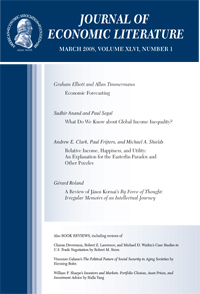Measurement Systems
IF 11.5
1区 经济学
Q1 ECONOMICS
引用次数: 3
Abstract
Economic models often depend on quantities that are unobservable, either for privacy reasons or because they are difficult to measure. Examples of such variables include human capital (or ability), personal income, unobserved heterogeneity (such as consumer “types”), et cetera. This situation has historically been handled either by simply using observable imperfect proxies for each of the unobservables, or by assuming that such unobservables satisfy convenient conditional mean or independence assumptions that enable their elimination from the estimation problem. However, thanks to tremendous increases in both the amount of data available and computing power, it has become possible to take full advantage of recent formal methods to infer the statistical properties of unobservable variables from multiple imperfect measurements of them. The general framework used is the concept of measurement systems in which a vector of observed variables is expressed as a (possibly nonlinear or nonparametric) function of a vector of all unobserved variables (including unobserved error terms or “disturbances” that may have nonadditively separable affects). The framework emphasizes important connections with related fields, such as nonlinear panel data, limited dependent variables, game theoretic models, dynamic models, and set identification. This review reports the progress made toward the central question of whether there exist plausible assumptions under which one can identify the joint distribution of the unobservables from the knowledge of the joint distribution of the observables. It also overviews empirical efforts aimed at exploiting such identification results to deliver novel findings that formally account for the unavoidable presence of unobservables. (JEL C30, C55, C57, D12, E21, E23, J24)测量系统
经济模型往往依赖于不可观测的数量,要么是出于隐私原因,要么是因为难以测量。这类变量的例子包括人力资本(或能力)、个人收入、未观察到的异质性(如消费者“类型”)等。历史上,这种情况的处理方法要么是简单地使用每个不可观测值的可观测不完美代理,要么是假设这些不可观测物满足方便的条件平均值或独立性假设,从而将其从估计问题中消除。然而,由于可用数据量和计算能力的巨大增加,可以充分利用最近的正式方法,从不完美的多个测量结果中推断出不可观测变量的统计特性。所使用的一般框架是测量系统的概念,其中观测变量的向量表示为所有未观测变量向量的(可能是非线性或非参数的)函数(包括未观测误差项或可能具有不可相加可分离影响的“扰动”)。该框架强调与相关领域的重要联系,如非线性面板数据、有限因变量、博弈论模型、动态模型和集合识别。这篇综述报告了在核心问题上取得的进展,即是否存在合理的假设,在这些假设下,人们可以从可观测物的联合分布的知识中识别不可观测品的联合分布。它还概述了旨在利用这些识别结果来提供新发现的实证努力,这些新发现正式解释了不可观测物不可避免的存在。(JEL C30、C55、C57、D12、E21、E23、J24)
本文章由计算机程序翻译,如有差异,请以英文原文为准。
求助全文
约1分钟内获得全文
求助全文
来源期刊

Journal of Economic Literature
ECONOMICS-
CiteScore
17.80
自引率
0.80%
发文量
49
期刊介绍:
Commencing in 1969, the Journal of Economic Literature (JEL) serves as a vital resource for economists, offering a means to stay informed about the extensive literature in the field. Each JEL issue features commissioned, peer-reviewed survey and review articles, book reviews, an annotated bibliography categorizing new books by subject, and an annual index of dissertations from North American universities.
 求助内容:
求助内容: 应助结果提醒方式:
应助结果提醒方式:


